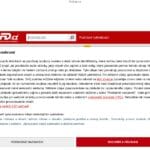blinksup.com Reviews
is blinksup.com legitimate or a scam?
Why is the trust score of blinksup.com strongly low?
Blinksup, which presents itself as a cryptocurrency exchange platform. Based on the information provided and standard industry practices, the following is a detailed analysis highlighting potential red flags, inconsistencies, and concerns regarding the legitimacy and trustworthiness of the platform.
1. Unrealistic Withdrawal Limits and Fees
Observation:
- High Minimum Withdrawal Amounts:
- In Section 5.4 of the User Agreement, it states: “The minimum withdrawal amount for users without premium status is 0.1 BTC.”
- In Section 12.4, it further mentions: “The minimum withdrawal amount for users without premium status is 0.49 BTC or other cryptocurrency equivalent.”
- Excessive Deposit Requirements:
- Users are required to make significant deposits to activate their accounts and for identity verification.
Analysis:
- Exorbitant Minimums:
- A minimum withdrawal of 0.1 BTC to 0.49 BTC (approximately $2,500 to $12,000 USD at current rates) is unusually high for any legitimate exchange, especially for non-premium users.
- Barrier to Fund Access:
- High withdrawal thresholds can prevent users from accessing their funds, effectively trapping their money on the platform.
Red Flag:
- Potential Financial Entrapment:
- These practices may be designed to collect deposits without the intention of allowing withdrawals, characteristic of fraudulent schemes.
2. Mandatory Tax Fees Payable via Deposit
Observation:
- Section 7.3 states: “When withdrawing funds, the user has to pay a tax fee. The tax fee is calculated as a percentage of the withdrawal amount.”
- Section 7.4 mentions: “The tax fee can only be paid with a deposit.”
Analysis:
- Unusual Tax Fee Structure:
- Legitimate exchanges deduct fees directly from the withdrawal amount or the user’s account balance, not through additional deposits.
- Requirement to Deposit More Funds:
- Requiring users to deposit additional funds to pay fees is a common tactic in advance-fee scams.
Red Flag:
- Advance-Fee Scam Indicators:
- This approach may be aimed at extracting more money from users under the guise of taxes or fees before releasing funds that may not exist.
3. Control Over Private Keys
Observation:
- Section 8.6 states: “Blinksup securely stores all Supported Cryptocurrency private keys (‘Private Keys’) associated with any Blinksup Account. You accept and agree that Blinksup shall retain full ownership and control of the Private Keys associated with your Blinksup Account and that you shall have no control of, access to, or the ability to use, such Private Keys.”
Analysis:
- Violation of Cryptocurrency Principles:
- In cryptocurrency, ownership and control over private keys are essential for security and autonomy.
- Custodial Risks:
- Users not having access to their private keys means they are entirely dependent on the platform for access to their funds.
Red Flag:
- Potential Misappropriation of Funds:
- Retaining full control over private keys without user access can facilitate unauthorized use or misappropriation of user assets.
4. Poorly Written Content and Inconsistencies
Observation:
- The website and user agreement contain numerous grammatical errors, typos, and poorly structured sentences.
- Example from the “About Us” section: “In our Exchange your funds This one, and lots of another features makes trading in Exchange very comfortable, useful and profitable.”
Analysis:
- Lack of Professionalism:
- Legitimate businesses typically ensure that their content is well-written and professionally presented.
- Potential Copy-Paste Content:
- Inconsistencies and errors may indicate that the content was hastily assembled or copied from other sources without proper proofreading.
Red Flag:
- Unprofessional Presentation:
- Poor quality content can be indicative of fraudulent websites attempting to appear legitimate without investing in professional development.
5. Unusual Identity Verification and Activation Process
Observation:
- Section 4.2 requires users to make a qualifying deposit in one payment to activate their account, referred to as “wallet-wallet verification.”
- Users must transfer funds before they can start transacting.
Analysis:
- Atypical Verification Methods:
- Standard identity verification involves providing personal documents, not making deposits.
- Potential for Fund Seizure:
- Requiring deposits for verification can be a tactic to collect funds without providing services.
Red Flag:
- Possible Financial Exploitation:
- This practice deviates from industry norms and may be designed to exploit users financially.
6. Conflicting and Unfair Terms in User Agreement
Observation:
- Unilateral Rights to Terminate Accounts:
- Section 4.3 allows Blinksup to restrict or suspend accounts at any time without notice.
- High Insurance Contributions for Certain Users:
- Section 11.2 imposes additional “insurance payments” of 0.1-0.5 BTC for users from certain countries, including new users and those from high-risk jurisdictions.
Analysis:
- Lack of User Protection:
- Terms heavily favor the platform, providing users with little to no recourse.
- Discriminatory Practices:
- Imposing higher fees based on nationality raises ethical and potentially legal concerns.
Red Flag:
- Exploitative Terms:
- Such terms can be used to justify withholding funds or demanding additional payments.
7. Misleading Premium Account Benefits
Observation:
- Section 12 promotes a “Premium Account” or “VIP Trading Account” with numerous benefits, such as personal account managers and higher profitability rates.
- To upgrade, users must make a corresponding deposit.
Analysis:
- Pay-to-Withdraw Scheme:
- Users may be required to upgrade to withdraw funds, effectively paying more to access their own money.
- Unsubstantiated Claims:
- Promises of higher profitability are vague and lack supporting evidence.
Red Flag:
- Deceptive Practices:
- The push to deposit more funds under the guise of enhanced benefits is a common tactic in fraudulent operations.
8. Absence of Regulatory Compliance and Licensing Information
Observation:
- The website and user agreement do not provide information about regulatory oversight, licenses, or compliance with financial authorities.
Analysis:
- Non-Compliance Risks:
- Operating a cryptocurrency exchange typically requires licenses and adherence to regulations in the jurisdictions served.
- User Vulnerability:
- Without regulatory oversight, users have limited protection against fraud or malpractice.
Red Flag:
- Potential Illegitimate Operation:
- Lack of transparency about regulatory compliance is a significant concern.
9. No Clear Company Information or Contact Details
Observation:
- The website lacks essential company information such as a physical address, company registration details, and verifiable contact information.
Analysis:
- Anonymity of Operators:
- Legitimate businesses provide verifiable contact details to establish trust.
- Difficulty in Seeking Recourse:
- Users cannot contact the company effectively in case of issues or disputes.
Red Flag:
- Lack of Transparency:
- Anonymity may be used to avoid accountability and legal action.
10. Inconsistent and Unfair Fee Structures
Observation:
- Variable Fees Without Notice:
- Section 7 mentions that data may change without notifying users.
- Mandatory Commissions on All Deposits and Withdrawals:
- Users are subject to commissions, and fees can be imposed arbitrarily.
Analysis:
- Unpredictable Costs:
- Users cannot anticipate the true cost of transactions.
- Potential for Hidden Fees:
- Lack of transparency allows for the imposition of excessive fees.
Red Flag:
- Financial Exploitation Risk:
- This can lead to unexpected losses and is not standard practice in reputable exchanges.
11. User Testimonials and Online Presence
Observation:
- There is no evidence of user testimonials, reviews, or an active online presence.
- No links to social media platforms or community engagement.
Analysis:
- Lack of Community Trust:
- Established exchanges typically have a presence on social media and engage with their user base.
- Potential Isolation:
- Absence of external validation raises concerns about the platform’s credibility.
Red Flag:
- Possible Scam Indicator:
- Scammers often avoid public scrutiny and limit avenues for users to share negative experiences.
Conclusion
The analysis reveals multiple red flags suggesting that Blinksup may not be a legitimate cryptocurrency exchange platform. The combination of unrealistic withdrawal limits, mandatory deposits under dubious pretenses, control over user private keys, and lack of transparency indicates a high risk of fraudulent activity.
Recommendations
- Avoid Engaging with the Platform:
- Do not deposit funds or provide personal information until the platform’s legitimacy can be thoroughly verified.
- Conduct Independent Research:
- Look for reviews, discussions, or warnings about Blinksup on reputable forums and websites.
- Verify Regulatory Compliance:
- Check with relevant financial authorities to determine if Blinksup is registered and licensed to operate as a cryptocurrency exchange.
- Be Wary of Upfront Fees:
- Legitimate exchanges do not require large deposits for account activation or charge withdrawal fees that must be paid via additional deposits.
- Protect Personal Information:
- Refrain from sharing sensitive data with platforms that lack clear security measures and privacy policies.
- Consult Financial Professionals:
- Seek advice from trusted financial advisors or legal professionals before engaging with the platform.
- Report Suspicious Activity:
- If you suspect fraudulent activity, report it to relevant law enforcement agencies and financial regulators.
Final Thoughts
The cryptocurrency market attracts both legitimate businesses and fraudulent actors due to its decentralized nature and the potential for high returns. It is crucial to exercise due diligence and remain vigilant when selecting platforms for trading or investing. Always prioritize the security of your funds and personal information by choosing reputable, transparent, and regulated exchanges.
the reasons behind this review :
Blinksup shows significant red flags—including unrealistic withdrawal limits, mandatory fees via additional deposits, and lack of transparency—that strongly suggest it may be a scam; users should exercise extreme caution.
| Positive Points | Negative Points |
|---|---|
Website content is accessible No spelling or grammatical errors in site content Whois data is accessible | Domain is new Archive is new |
How much trust do people have in blinksup.com?
Domain age :
1 days
WHOIS Data Status :
Accessible
Website :
BLINKSUP.COM
Title :
cache:https://blinksup.com - Google Search
Website Rank :
N/A
Age of Archive :
0 year(s) 0 month(s) 1 day(s)
SSL certificate valid :
Valid
SSL Status :
Low - Domain Validated Certificates (DV SSL)
SSL issuer :
Google Trust Services
WHOIS registration date :
2024/09/23
WHOIS last update date :
2024/09/25
WHOIS Renewal Date :
2025/09/23
Organization :
Wintera
State/Province :
Colorado
Country :
US
Phone :
+1.7202666813
Email :
hsdhf7hh3r@proton.me
Organization :
Wintera
State/Province :
Colorado
Country :
US
Phone :
+1.7202666813
Email :
hsdhf7hh3r@proton.me
Organization :
Wintera
State/Province :
Colorado
Country :
US
Phone :
+1.7202666813
Email :
hsdhf7hh3r@proton.me
IP : 104.21.6.207
IP : 172.67.135.68
Name :
PDR Ltd. d/b/a PublicDomainRegistry.com
IANA ID :
303
Registrar Website :
www.publicdomainregistry.com
Phone :
+1.2013775952
Email :
abuse-contact@publicdomainregistry.com
Target : veronica.ns.cloudflare.com
IP : 162.159.38.173
Target : seth.ns.cloudflare.com
IP : 108.162.193.142
This website was last scanned on October 15, 2024

midmodstuff.com
https://midmodstuff.com redirected to http//www.midmodstuff.com during the time we crawled it. Midmodstuff.com is a website that specializes in selling affordable mid-century modern furniture, lighting, and accessories. The site features a range...

csfd.cz
https://csfd.cz redirected to https//www.csfd.cz during the time we crawled it. The website is a Czech and Slovak film database, providing information about movies, TV shows, and actors. It's a popular...

Carfax.services
https://Carfax.services redirected to https//carfax.services during the time we crawled it. The website carfax.services raises several red flags that are commonly associated with scam websites: 1. **Domain Name**: The domain name...

